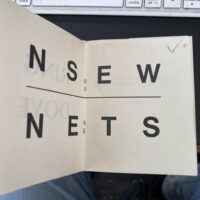A TYPED LETTER SIGNED BY FINLAY TO FRED HUNTER DATED 11 JULY (1963).
A typed letter signed by Finlay to his friend Fred Hunter (dated July 11th [1963]) on two sheets of light typing paper - each 12.7 x 20.2cm, 1pp. There are approximately 353 words, with one holograph correction. Finlay writes: “I also enclose a catalogue Jessie [McGuffie] and I made, for the gallery Jessie was to run here; unfortunately, the nasty posh lady who owned the gallery, objected to some of the people who were invited to the opening, and there was an argument, and Jessie got sacked, whereupon the artist withdrew his paintings, so there never WAS an exhibition.” Elsewhere, Finlay thanks Hunter “for the pound… the Wild Hawthorn is certainly always glad of money”; mentions Fish-Sheet (“I hope to do it, at irregular intervals”), and informs that “Next Poth will be 8”. Other chat refers to Hunter having bought “the concretes of [sic] A D'Offay; I just hope it wasn’t a disappointment for you; it worries me”, and a promise to dig out back issues of Migrant for him that “are shut away in a teachest, in a friend’s house”.
This letter was sent by Finlay along with the handout for the Patriot Gallery (which has a separate listing in this collection) which is the exhibition by Stitt he refers to in this letter. "I also enclose a catalogue Jessie and I made, for the gallery Jessie was to run here, unfortunately, the nasty posh lady who owned the gallery, objected to some of the people who were invited to the opening, and there was an argument, and Jessie got sacked, whereupon the artist withdrew his paintings, so there never WAS an exhibition. However the artist gave us three prints of his etching, Bird descending, and I thought you might like to have one as a little present so here it it. P Stitt has much nicer things but he will certainly be famous one day, so the etching will be good to have...."
Slightly creased, with Fred Hunter’s two-word ink marginalia on second page and paper a little yellowed. Else VG+. An interesting letter giving context to the gallery handout and noting a very early Finlay falling out with someone!




























